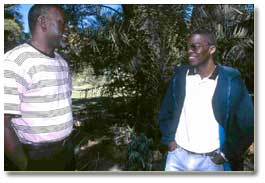January, 2005
 In recent years, CIMMYT’s collaboration with partners in the South Africa Development Community (SADC) has flourished in scope and strength to span research, training, and shared experiences with researchers, extension workers, farmers, seed companies, and four national universities. The various parties bring their strengths to this alliance, resulting in synergy and a fluid transfer of impact-oriented technologies and knowledge to smallholder farmers.
In recent years, CIMMYT’s collaboration with partners in the South Africa Development Community (SADC) has flourished in scope and strength to span research, training, and shared experiences with researchers, extension workers, farmers, seed companies, and four national universities. The various parties bring their strengths to this alliance, resulting in synergy and a fluid transfer of impact-oriented technologies and knowledge to smallholder farmers.
From the Ivory Tower to Farmers’ Fields
Mick Mwala’s friends have nicknamed him “Dr Mobile.” On any given day he can be found at any of three or more places: the lecture halls and laboratories of the Department of Crop Science at the University of Zambia (UNZA), interacting with his students at the CIMMYT-Zimbabwe research station, or in the field visiting smallholder farmers who host “baby” trials in farmer-participatory maize variety evaluations (popularly known as mother-baby trials ) throughout the SADC region. Occasionally, he will also call on the offices of local seed companies to chat about the varieties being tested in the field. The only way to reach Mwala on weekdays is via his mobile phone, hence the nickname.
Mwala, a Senior Lecturer at the University of Zambia (UNZA), is among the many individuals who supply impetus to agricultural progress in the region. Since 2000, he has been allocating 30% of his time to providing regional leadership within CIMMYT’s southern African research agenda. “I advise national research and extension staff in 10 southern African countries, each of them leading a network among farmer and partner organizations to identify new maize varieties suitable to smallholder conditions,” he explains. Marianne Bänziger, director of CIMMYT’s African Livelihoods Program, sees Mwala’s secondment to CIMMYT as one approach to an extremely productive collaboration between an international agricultural research center and the present expertise of African universities, and Mwala concurs.
“Many universities had become ivory towers, with little actual connection to the development issues their research and training activities should address,” he says. His focus on CIMMYT has involved him in a highly relevant, cooperative effort allowing CIMMYT’s state-of-the-art science and technologies—such as new breeding approaches for drought tolerance, or GIS tools—to be utilized. “The experience has definitely cross-fertilized my approach to teaching at the university and equipped me with a developmental perspective towards training and research,” Mwala says. The expanse of collective knowledge is also shared among international agricultural research centers, national agricultural research systems (NARS), non-governmental and community-based organizations, church-based groups, schools, the private sector, and with individual smallholder farmers. In turn, CIMMYT has gained much from Mwala’s experience in capacity building and his intrinsic knowledge of southern Africa and its people.
New Challenges Add a New Dimension to Collaboration
For many decades, agricultural research institutions have grappled with how to design variety release systems that are more responsive to smallholder farmers’ needs. Farmers’ access to seed must be improved, especially for those who have to travel long distances. By partnering with institutions possessing broad and in-depth knowledge of the southern Africa region, its people, cropping systems, and technology transfer approaches, international centers such as CIMMYT are better able to deliver innovative science-based solutions for improved livelihoods.
A troubling phenomenon that Mwala has observed in the course of his work is the extremely high staff turnover rate in the region’s NARS. “It is not unusual for the staffing profile of an institution to completely change in a given year, and this presents a tremendous challenge to agricultural development,” he states. Bänziger estimates that half of the maize breeders in southern Africa leave their posts within three years, and she notes, “This is less time than is needed to identify a variety for release to farmers.” Staff trained in the 1980s are approaching retirement or have already done so
In addition, most staff joining NARS come only with a fresh BSc degree, and the experienced people are involved in management rather than research or have moved to greener pastures. In recent times, many succumb to illness, ranging from preventable diseases like malaria to terminal conditions like HIV/AIDs. Donor investments in graduate training have decreased to the extent that few universities in the region can maintain viable MSc programs.
To address these issues in a more coordinated fashion, Mwala, in collaboration with CIMMYT, obtained support from The Rockefeller Foundation in 2003 for MSc training of NARS scientists at the University of Zambia. Six scientists are completing their research projects at four international centers in the region—CIMMYT, ICRISAT, CIAT and IITA/SARNET —following a year’s course work at university.
Dibanzilua Nginamau, one of the Rockefeller-supported students, says, “I could never have done an MSc degree in plant breeding in Angola, because my country does not have a postgraduate program in that field. While at UNZA, I met colleagues from Zambia, Mozambique, and Tanzania who, like me, were breeders confronted with a tremendous responsibility and no postgraduate education.” The course work at UNZA coupled with his applied research at CIMMYT has equipped Nginamau with the skills, competence, and confidence to breed successfully for Angola’s needs. “I can now lead my own breeding program back home!” he says.
Gaining from this network are farmers, scientists, NARS, universities and their students, as well as organizations like CIMMYT. Building on relationships and working together is essential for smooth transfers of knowledge to the farmers. It is also more cost-effective. “Working together actually required fewer resources than if we had all gone down the path on our own,” Mwala concludes.
 Poverty reduction, livelihoods and jobs
Poverty reduction, livelihoods and jobs 
